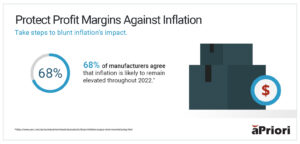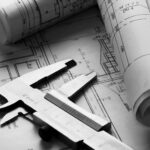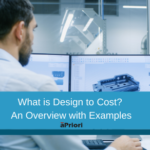
The hits just keep coming. Last week, the Federal Open Market Committee (FOMC) voted for another interest rate hike. In an effort to stem high inflation, the rate will increase by 75 basis points with a new target range for federal reserve funds at 3.00% to 3.25%.
Though it is designed to mitigate inflationary pressures, manufacturers are still grappling with ongoing supply chain issues, skilled worker shortages, and higher material and fuel prices.
Although many manufacturers have reduced their supply vulnerabilities, 73% of companies said their current supply chains are not fully protected, and 12% believed their supply chains lack resilience. To add to the pain, high borrowing costs persist, creating a ripple effect throughout other industries. Manufacturers continue to deal with skilled worker shortages. Some analysts predict that the latest fed rate hike could lead to unemployment rising from the current 3.7% to 4.4% by the end of next year. According to an article in Deloitte, the manufacturing sector lost 578,000 jobs during the pandemic in 2020. Even more alarming, US manufacturing is expected to have 2.1 million unfilled positions by 2030.
This article will recap those challenges and provide three strategies manufacturing executives can implement now to combat inflation to ensure a more productive and profitable 2023.
Three Moves to Make Now for a Better 2023:
In the words of The Greatest Salesman in the World author Og Mandino, “What you plant now, will harvest later.” Lay the groundwork today for a more productive, profitable tomorrow. These three strategies can help you get there:
- Shore up your supply chain: Supply chain disruptions could last into 2023, according to the National Association of Manufacturers (NAM). Ninety percent of respondents reported suffering either significant (52.5%) or partial (39%) disruption in the past two years. It is confounding that just 19% of respondents had fully integrated supply chain structures. The survey found lapses were due to digital maturity disparities from partners (54%); lack of common data platforms (53%); traditional supply chain transformation issues (29%); and legacy upgrade challenges (26%).
Gain more clarity into your supply chain options: To do so, you need a solution that provides insights and options that address all aspects of the product lifecycle that ultimately influence supply chain effectiveness. It must provide manufacturers with data on potential supply chain regions as well as whether a product or part is even manufacturable. For instance, a casting you’ve been making for years suddenly might not be feasible. It could be difficult to make. The number of suppliers with the required materials available might be limited, compromising your operations and profitability. Worse, if their supply chains are impeded or halted altogether, the casting you’ve made for years may no longer be viable.
How aPriori Can Help: Manufacturers can gain valuable information about the feasibility of a part or product from the right platform. aPriori’s platform provides Regional Data Libraries covering 87 global regions. Amid supply chain issues, manufacturers can better strategize where and how they will obtain needed raw materials through these libraries. Compare material and shipping costs from one supplier region to the next. Weigh the benefits of paying a little more for supplies that are closer to your geographic operations (faster and easier to obtain) vs. those that are less expensive but must go through a more extensive supply chain (slowing supply delivery and time to market).
To combat higher prices, ensure you get the parts you need, and model future materials planning, you also can use a materials cost calculator. Get costs under control before production rather than reacting to them mid-production. Beat cost fluctuations before they jump up again due to another inflation hike or material shortage crisis. Such insights nip supply chain issues in the bud before they become unmanageable. Finally, tools like aPriori’s can work around supply chain issues with redesign capabilities, allowing manufacturers to create the part using other available materials.
- Build your cashflow reserves: An August survey of CEOs found that 81 percent of leaders expect a recession. Continued inflation rate hikes mentioned above add to manufacturers’ pain. Short-term strategies such as pricing adjustments, reducing operating expenses, and managing exposure to input costs are helpful.
Implement more structural solutions: Manufacturers need to take a long view, implementing more structural solutions such as sustainability initiatives. The McKinsey article noted that a through-cycle view on sustainability can help companies build resilience, reduce costs, and create value. With sustainability as an initiative for many manufacturers, it is imperative that they look for a platform that can support them.
How aPriori Can Help: aPriori has the ability to help manufacturers proactively reduce their carbon footprint through designing for sustainability. The result is more cost-effective design. A solution like aP Generate analyzes a 3D CAD model to determine if a design is cost-prohibitive or too difficult to manufacture (using up resources and slowing time to market). If the former, both the cost engineer and designer will be notified of the issue. Then they can use the platform’s manufacturing insights to make design adjustments, identify and eliminate cost outliers, or determine its manufacturing feasibility. It can ensure that manufacturability, sourcing, and costs are in alignment. Another cost benefit of such a tool is that it boosts collaboration and negotiating power with suppliers. It provides current, fact-based data on supplier prices throughout the 79 regions.
The Federal Government is helping to ease sustainability costs for manufacturers. The Inflation Reduction Act is a bill that features $370 billion in spending and tax incentives on energy and climate change provisions. Section 48C Manufacturers’ Tax Credit proposes an expansion of this credit, including advanced energy properties designed to reduce greenhouse gas emissions as potentially determined by the IRS. Additionally, it could include any property that re-equips existing infrastructure to reduce greenhouse gas emissions by at least 20%. It potentially could make way for new technologies to take advantage of these credits in the future. aPriori customers that implement green factory initiatives could possibly benefit.
- Continue to strengthen your workforce: A Gartner survey noted that 49% of CEOs agreed with the statement that “it is very difficult for us to find and hire the kind of people we need in our business.” With many leaving the workforce for reasons such as burnout and retirement, shortages of skilled workers have become an ongoing problem.
Workers expect more from their employers including a better work-life balance, more education and career development opportunities, and greater job satisfaction. How can manufacturers mitigate labor shortages, provide upskilling opportunities, and improve attraction and retention rates?
A Deloitte survey noted that 57% of executives who enhanced technologies used daily by employees elevated those workers’ experiences and satisfaction. More workers expect upskilling opportunities, particularly with technology. As a result, these employees acquire invaluable knowledge and experience to build a technology-based career. Additionally, the manufacturer fosters talent for the organization’s future, strengthening its position in the marketplace. Manufacturers that invest in their employees and nurture their career growth tend to attract and retain workers.
Combine career development with the latest technologies: Technology is key to this process as more incoming talent craves a technology-based organization and a position that aligns with it. Combining career development and the latest technologies is integral to mitigating labor shortages and reducing employee attrition. Additionally, cultivating future talent will close the gaps left by more experienced workers who retire or leave for other positions. They can onboard faster too.
How aPriori Can Help: Product lifecycle management tools like aPriori offer the training to get workers up to speed faster and more cost-effectively. These tools also provide more upskilling opportunities in safer environments with better manufacturing technologies. Consequently, automation improves productivity, enabling faster time to market and competitiveness. It also allows manufacturers to do more with fewer resources. Finally, it removes more rudimentary tasks, so specialists can focus on more technical issues. Such tools also increase average production output by 10%, factory capacity utilization by 11%, and labor productivity by 12%.
Sow the Seeds Today for a Bountiful Harvest Tomorrow
The right manufacturing simulation platform can support manufacturability, cost, and sustainability initiatives. What’s more, such a platform optimizes your manufacturing operations, workforce, products, supplier relationships, and costs.
Sow the seeds today. You will lay the foundation for a bountiful harvest come 2023.
How can aPriori make 2023 better for you?
So many questions, so little time. We’ve got the answers!






